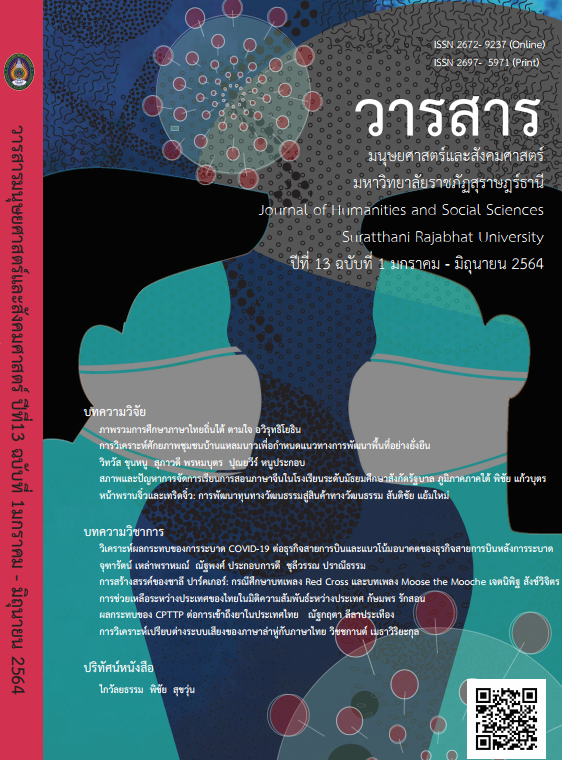Thai Foreign aid in International Relations
Main Article Content
Abstract
This article aims to study Thai foreign aid in aspect of international relations resulting from the shifts in global system in terms of economic, societal, and political power, which brings about unparalleled development among states. Foreign aid becomes a tool of more powerful states providing the aid for development to weaker states, for example, in the case of poverty, disaster, and epidemic disease. Foreign aid can be implemented in from of offering cash, loan or objects. The impact of foreign aid leads to the increasing production and employment, the reduction of poverty, and enhanced diplomatic relations among states. It is potential for Thailand to create good allies with neighbours by adopting foreign aid as a diplomatic tool. Nonetheless, through neighbours’ perspective, the fact that Thailand plays its role as a donor state can bring about managing and gaining economic benefits from neighbours.
Article Details

This work is licensed under a Creative Commons Attribution-NonCommercial-NoDerivatives 4.0 International License.
All published manuscripts have been verified by peer-peer professors in the fields of humanities and social sciences. Reprinting of the article must be authorized by the editorial staff.
References
กรมความร่วมมือระหว่างประเทศ (2561). กระทรวงการต่างประเทศ. [Online]. เข้าถึง
ได้จาก http://www.tica.thaigov.net/main/th/aid/10737. [2562,
พฤษภาคม 22 ].
กรมประชาสัมพันธ์ (2561, ธันวาคม 14). นายกรัฐมนตรีนำคณะรัฐมนตรีร่วมการ
ประชุมร่วมนายกรัฐมนตรีและรัฐมนตรีไทย- ลาว อย่างไม่เป็นทางการ ครั้งที่ 3
เน้นความเชื่อมโยงในทุกมิติแบบไร้รอยต่อ. [Online]. เข้าถึงได้จาก http://
thainews.prd.go.th/th/website_th/news/news_detail/TN
POL6112140010006. [2563, สิงหาคม 16].
กรมเศรษฐกิจระหว่างประเทศ (2558). ยุทธศาสตร์ความร่วมมือทางเศรษฐกิจอิรวดี -
เจ้าพระยา - แม่โขง (ACMECS). [Online]. เข้าถึงได้จาก http://www.mfa.
go.th/business/th/cooperation/ [2563, สิงหาคม 16].
ข่าวสด (2561, กรกฎาคม 25). "รัฐบาลไทย" มอบ 5 ล้าน ช่วยชาวลาว หลังเขื่อนแตก
น้ำท่วมวิกฤต. [Online]. เข้าถึงได้จาก https://www.khaosod.co.th/
breaking-news/news_1374662. [2563, สิงหาคม 16].
ไทยโพสต์ (2561, กันยายน 3). จีนใจป้ำ เสนอเงินช่วยแอฟริกาอีก 1.9 ล้านล้านบาท.
[Online]. เข้าถึงได้จาก https://www.thaipost.net/main/detail/16737.
, มกราคม 24].
โพสต์ทูเดย์ (2558, กุมภาพันธ์ 25). ไทย-กัมพูชาร่วมพัฒนาหมู่บ้านตามหลักศก.พอเพียง.
[Online]. เข้าถึงได้จาก https://www.posttoday.com/social/
local/349623. [2563, สิงหาคม 16].
ว้อยซ์ ทีวี (2563, กรกกฎาคม 15). ครม.เห็นชอบปล่อยกู้เมียนมา 1,485 ล้านบาท แถม
ปลอดหนี้ 10 ปี. [Online]. เข้าถึงได้จาก https://www.sanook.com/
news/8208562/. [2563, สิงหาคม 16].
Alesina, A. and Dollar, D. (2000). Who Gives Foreign Aid to Whom and Why?.
Journal of Economic Growth. 5(1), 33-63.
Africa Hunger and Poverty Facts (2018). African page. [Online]. Retrieved
from https://www.worldhunger.org/africa-hunger-poverty-
facts-2018/. [2019, July 14].
Binagwaho, A. (2018). The Road Ahead for US Foreign Aid to Africa. [Online].
Retrieved from https://www.aspeninstitute.org/blog-posts/
the-road-ahead-for-us-foreign-aid-to-africa/ . [2019, October 21].
Breuning, M. and Ishiyama, J. T. (2003). Donor Characteristics and the
Dispersion of Foreign Assistance. International Politics. 40(2), 249-
Bueno de Mesquita, B. and Smith, A. (2011). The Dictator’s Handbook. New
York: Public Affairs Press.
Carr, E. H. (2001). The Twenty Years' Crisis. New York: Palgrave.
Glassman, J. (2011, April 8). Foreign Aid : The Good And Bad. Forbes.
[Online]. Retrieved from https://www.forbes.com/sites/jamesglassman
/2011/04/08/foreign-aid-the-good-and-bad/#47a67f887257.[2019, July 12].
Hook, S.W. and Zhang, G. (1998). Japan’s aid policy since the Cold War:
rhetoric and reality. Asian Survey. 38, 1051–1066.
Lancaster, C.(2007). Foreign aid: Diplomacy, development, domestic
politics. Chicago: The Chicago University Press.
Masud, N. and Yontcheva, B. (2005). Does Foreign Aid Reduce Poverty?
Empirical Evidence from Nongovermental and Bilateral Aid. IMF
Working Paper, WP/05/100. International Monetary Fund.
Meservey, J. (2020). China’S Palace Diplomacy in Africa. [Online]. Retrieved
from https://warontherocks.com/2020/06/chinas-palace-diplomacy-
in-africa/. [2020, August 14].
Morgenthau, H. (1962). A Political Theory of Foreign Aid. American Political
Science Review. 56(2), 301-309.
Nissanke, M. and Thorbecke, E. (2010). Linking Globalization to Poverty in Asia, Latin America and Africa. Policy Brief. [Online]. Retrieved from
https://www.wider.unu.edu/sites/default/files/PB2010-003.pdf . [2019,
July 21].
Niyonkuru, F. (2016). Failure of Foreign Aid in Developing Countries: A Quest
for Alternatives. Business and Economic Journal. 7(3), 2-9.
Quinn, J. and Simon, D. J. (2006). Plus ça change: The Allocation of French
ODA to Africa During and After the Cold War. International
Interactions. 32(3), 295-318.
Rajan, R. and Subramanian, A. (2005). Aid and Growth: What Does the
Cross-Country Evidence Really Show?. IMF Working Paper,
WP/05/127. International Monetary Fund.
Reci, A. (2014). Advantages and disadvantages of foreign assistance in
Albania. Forum Scientiae Economic. 2(3), 123-132.
Seo, H. (2017). Politics of Aid: A Closer Look at the Motives Behind Foreign
Assistance. Harvard International Review. 38(2), 42-47.
Tuman, J.P. and Ayoub, A. S. (2004). The determinants of Japanese official
development assistance in Africa: a pooled time series analysis.
International Interactions. 30, 45–59.


